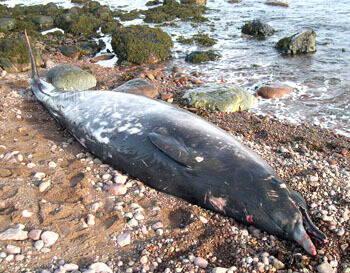Mesoplodon grayi
IUCN
LCBasic Information
Scientific classification
- name:Mesoplodon grayi
- Scientific Name:
- Outline:Cetacea
- Family:D.whale
Vital signs
- length:2-6m
- Weight:1-1.5 tons
- lifetime:No verification information
Feature
The lip line is quite straight, and the beak is white and slender
Distribution and Habitat
South of 30°S, the distribution is circumpolar. Most of the information is from strandings in New Zealand, although there are increasing reports from Tierra del Fuego, the Falkland Islands, South Africa, Australia, and the Chatham Islands. Only one stranding has been recorded in the northern hemisphere: off the north coast of the Netherlands in 1927; no other records have been made from the area before or after this, so it is possible that this whale got lost. Many sightings have been recorded in deep waters south of Madagascar. A possible sighting in the Seychelles in the early 1980s saw three adults and one calf.
Appearance
Although it is difficult to identify males in the ocean, it is not impossible: their straight lip line and thin white beak are very distinctive, and they are often seen on the surface. Although most of the relevant information comes from stranded dead whales, there have been several confirmed sightings, mainly in the southern Indian Ocean. Males have two relatively small triangular teeth, which grow slightly behind the tip of the jaw and are visible even when the male closes his mouth; females usually have no teeth. Both sexes have rows of small rudimentary teeth on the upper jaw, which are embedded in the gums rather than deeply embedded in the jawbone. They are located behind the main teeth and are usually visible. Oulodon has rudimentary teeth, but they usually do not grow out. Some people have proposed to assign Gray's beaked whale to a new genus, Oulodon, but this has not been widely accepted. From the limited information currently available, it is inferred that Gray's b
Details
Gray's Beaked Whale's scientific name is Mesoplodon grayi, and its foreign name is Gray's Beaked Whale. Limited sightings show that they may be more conspicuous than other beaked whales on the sea surface, seem to be more active, and live in large groups. Gray's whales.html">Beaked Whales have been observed alone, in pairs, or in small groups; but the mass stranding of 28 Gray's whales.html">Beaked Whales on Chatham Island in eastern New Zealand in 1874 showed that larger groups may be encountered. Some people have seen them leaping up and hitting the waves at a gentle angle, with their entire body and tail fin jumping out of the water. Some people have also observed that when swimming quickly, they swim in a low arc, similar to the dolphin-like swimming of right whales. When Gray's Beaked Whales float up to breathe, they usually extend their white beaks out of the water.

Protect wild animals and eliminate game.
Maintaining ecological balance is everyone's responsibility!








